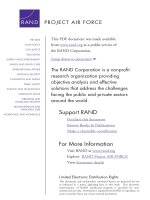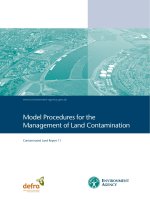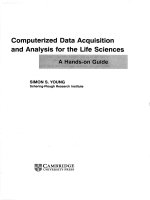3D facial model analysis for clinical medicine
Bạn đang xem bản rút gọn của tài liệu. Xem và tải ngay bản đầy đủ của tài liệu tại đây (6.77 MB, 114 trang )
3DFACIALMODELANALYSIS
FORCLINICALMEDICINE
LIU YI LIN
NATIONAL UNIVERSITY OF SINGAPORE
2013
3DFACIALMODELANALYSIS
FORCLINICALMEDICINE
LIU YI LIN
(M.Eng. Jilin University, China)
A THESIS SUBMITTED FOR THE DEGREE OF DOCTOR OF PHILOSOPHY
DEPARTMENT OF MECHANICAL ENGINEERING
NATIONAL UNIVERSITY OF SINGAPORE
2013
Declaration
I
Declaration
I hereby declare that this thesis is my original work and it has been
writtenbymeinitsentirety.Ihavedulyacknowledgedallthesourcesof
informationwhichhavebeenusedinthethesis.
This thesis hasalso not been submitted for any degree in any university
previously.
LiuYiLin
Dec2013
II
Acknowledgments
First I must express mysincere appreciation to mysupervisor, Associate
Professor Lee Heow Pueh for his invaluable direction, great patient,
continuous support and personal encouragement throughout my PhD
studies. I indeed have not only obtained a considerable number of fresh
ideasfromthediscussionswithhim,butalsolearnedand
benefittedfrom
hisinsightfulcommentsandcritiques.
I would like to thank Dr Ngo Yeow Seng Raymond, Associate Professor
Kelvin Foong, Dr Lee Shu Jin, Dr Saurabh Garg and Mr Tok Wee Wah
whohave made mystudy possiblethroughtheir generousguidanceand
support.
I gratefully acknowledge the financial
support provided by National
UniversityofSingapore throughtheResearchScholarshipwithoutwhich
itwouldhavenotbeenpossibleformetohavethechanceofworkingfor
mydegreeinNUS.
Acknowledgments
III
Ialsowanttoexpressmygreatthankstoallthelabofficersandfriendsin
theDynamicLabfortheirsupportandencouragementinthecourseofmy
PhDstudy.Finallyspecialthankstomyparentfortheirendlessloveand
support. I would not have been able
to finish this thesis without their
encouragement.
LiuYiLin
Dec2013
Tableofcontents
IV
Tableofcontents
Declaration I
Acknowledgments II
Tableofcontents IV
Abstract VII
ListofTables IX
ListofFigures X
Acronyms XIV
Chapter1. Introduction 1
1.1 Facialparalysisanddiagnosis 2
1.1.1 FacialParalysis 2
1.1.2 ClinicalFacialParalysisAssessmentMethods 5
1.1.3 2DImageandVideoBasedComputerAidedDiagnosis.9
1.2 FacialhighlightFeaturesAnalysis 13
Tableofcontents
V
1.3
ObjectivesoftheThesis 18
1.4 OverviewoftheThesis 19
Chapter2. Methodology 21
2.1 3DCurvatures 21
2.2 IterativeClosestPoint 30
2.3 ArtificialNeuralNetwork 32
Chapter3. ObjectiveGradingSystemforFacialParalysisDiagnosis 41
3.1 Overview 41
3.2 Dataacquisition 43
3.3 ObjectiveMeasurementofthesurfacecontour 47
3.4 Asymmetrydegreeindex 51
3.5 NoiseInjectedNeuralNetwork 55
3.6 PerformanceEvaluation 58
3.7 Results 59
3.8 DiscussionandConclusion 65
Tableofcontents
VI
Chapter4.
FacialHighlightFeaturesAnalysis 68
4.1 Introduction 68
4.2 DataAcquisition 69
4.3 Highlightregionextraction 74
4.4 Facialhighlightfeatures 77
4.4.1 Highlightregionsdistribution 78
4.4.2 Highlightofnasalbridge 78
4.4.3 Schemaofforeheadhighlightregion. 79
4.5 3DObjectiveMeasurementofthesurfacecontour 83
Chapter5. Conclusion 86
References 90
VII
Abstract
This thesis aims to investigate both facial paralysis diagnosis and facial
highlightfeaturesbasedon2Dand3Dfacialmodels.
First, a novel automated objective asymmetry grading system is
developedforfacialparalysisdiagnosis.Thedevelopmentofthisgrading
systemcombinesobservationsandclinicalassessmentsofthepatientsfor
different degrees
of motion dysfunctionin various facial expressions. To
improvetheperformanceofthesystem,higherordersurfacepropertiesin
facial imaging technique for 3D model analysis are used. Also, to
overcome the subjectivity of diagnosis encountered by the landmark
based computer aided grading methods, facial symmetry grading is
carried out
based on fine registration result of the original and mirror
facial meshby the iterated closest‐point algorithm (ICP), which doesnot
rely on any landmarks. Moreover, to avoid overfitting caused by small
sampleset,thenoiseinjectedartificialneuralnetworks(ANNs)infeature
extractionandclassificationfor3Dobjectswere
implemented. Compared
with standard ANNs, the accuracy, sensitivity and specificity of the
Abstract
VIII
proposed noise‐injected ANNs are significantly improved. The system is
alsotestedwithdataofpatientshavingfollow‐uptreatmentanddiagnosis
after the initial treatment. The proposed ANN system can detect the
improvement of the patients quite well. A plausible explanation of the
appreciablyimprovedperformanceisthat
theinjectednoiseincreasesthe
generalizationability,andreducesthesensitivitytothedisturbanceinthis
manner.
Meanwhile,thehighlightfeaturepatternsofnaturalfacesareexploredas
a planning aid for plastic surgery. Different from previous reported
studiesonattractivefacepatterns,whichhavemainlybasedtheircriteria
onfacial
profile,thisstudyintendstodeterminethepositionandshapeof
the highlights of natural faces across race and gender. Some relevant
conclusions can be drawn from the present study. First, nasal highlights
arediscontinuous,thusthe implantorfillershouldkeep thedorsumand
tipat differentlevels.Second,
theshapeofthenasionsaddleis intimately
associatedwithrace.Also,theforeheadhighlighthasmainlytwotypes,T
shape and maple leaf shape. The distributions of these two types are
closelyrelatedtoraceandgender.
IX
ListofTables
Table 2.1 Surface shapes and their corresponding principal, mean and
Gaussiancurvatures,andtheShapeindex
53
. 26
Table3.1Thresholdvaluechosenforno‐matchpointsfilter. 55
Table 3.2 Results provided by the ANNswith input of{RD, RGC} in the
conventionalmannerandwithnoise‐injectedmethods. 62
Table 3.3 Results provided by the ANNs with input of {RD, RSI} in the
conventionalmannerandwithnoise‐injectedmethods. 63
Table 3.4 Diagnosis results comparison for the patients before and after
medicaltreatments 64
Table4.1Age,raceandgenderinformationofsamplesubjects 70
Table4.2Raceandgenderdistributionsofthehighlightshapeonthenasal
bridge. 79
Table 4.3 Race and gender distributions of the forehead highlight shape
forthe64subjects. 81
ListofFigures
X
ListofFigures
Figure 1.1 Patients with Bell’s palsy.
7
(a) Asymmetric elevation of brow
andwrinklingoftheforehead;(b)Incompleteeyelidclosure;(c)Flattened
nasolabialfoldandpoorturningupwardoftheleftsideofmouth. 3
Figure1.2Anatomyofthefacialnerve.
9
4
Figure1.3SFGSstandardform. 9
Figure1.4ComparisonoftwopictureswithAndieMacDowellindifferent
ages. 13
Figure1.5StudyoftheproportionsofhumanbodyandheadbyLeonardo
daVinci. 16
Figure 1.6Makeup expertapplies highlightfoundationon theface of the
model,andtriestoenhancethefacialfeatures.
46
17
Figure1.7Overviewoftheobjectiveasymmetrygradingsystem 19
Figure2.1Normalplanesindirectionsofprincipalcurvaturesofasaddle
surface.
51
22
ListofFigures
XI
Figure 2.2 The Shape index as a shape descriptor for different shape of
surface
53
. 25
Figure2.3ArchitectureofArtificialneuralnetwork 33
Figure2.4Modelofaneuronk. 34
Figure 2.5 Architectural graph of multilayer perceptron feedforward
networks. 36
Figure 2.6 Overfitting occurs when excessivenumberof nodes isused in
theMLPneuralnetwork. 39
Figure3.1(a)3dMDfacesystemand(b)reconstructed3Dimage. 44
Figure3.2Detailoftriangulatedpolygonfacialmesh. 44
Figure3.33Dmodelsoffaceacquiredby3dMDsystemforfourdifferent
expressions: (a) straight and natural stare, (b) smiling to show teeth, (c)
raisingeyebrowtowrinkleforehead,and(d)closingtheeyestightly. 46
Figure3.4Renderingof(a)Gaussiancurvatureand(b)ShapeIndexcolor
mapon3Dfacescanmodelofsmilingtoshowteethexpressions. 50
Figure3.5RegistrationbetweenoriginalandmirrorfacesbyICP.
80
52
ListofFigures
XII
Figure3.6(a)Originalmesh.(b)Mirrormesh.(c)ICPregistrationresultof
originalandmirrormeshes. 52
Figure 3.7 Color maps of the difference between the original and mirror
meshes. (a) Geometry Distance, (b) difference of the Gaussian curvature
and(c)differenceoftheShapeIndex. 54
Figure4.1Anatomyofhumanface. 68
Figure 4.2 Anterior and lateral facial views of six sample subjects. Rows
correspond to six subjects of (a) Chinese male, (b) Chinese female, (c )
Eurasianmale,(d)Eurasianfemale,(e)Caucasianmale,and(f)Caucasian
female.Columnscorrespondtodifferentviewsof(1)anteriorview,and(2)
lateralview. 72
Figure 4.3 (a) Plaster cast of nose region; (b) 3D model reconstructed by
scanningtheplastercast. 73
Figure4.4Grayscaleimagewithnosetiplandma rkprnandalarlandmark
aladded. 74
Figure 4.5Facial highlightregionextractionprocess. Rows correspondto
sixsubjectsof(a)Chinesemale,(b)Chinesefemale,(c)Eurasianmale,(d)
Eurasian female, (e) Caucasian male, and (f) Caucasian female. Columns
ListofFigures
XIII
correspondtohighlightextractionstepsof(1)grayscaleimage,(2)setting
gray level threshold for grayscale image, and (3) extracted highlight
regions. 76
Figure 4.6 Two type of forehead highlight regions: (a) T shape, and (b)
Mapleleafshape. 80
Figure4.7Gaussiancurvaturevaluecolormap 84
Acronyms
XIV
Acronyms
2D Two‐Dimensional
3D Three‐Dimensional
AI ArtificialIntelligence
ANNs Artificialneuralnetworks
BP Back‐Propagation
CT ComputedTomography
FP FacialParalysis
FPRP FacialParalysisRecoveryProfile
HBGS House‐Brackmanngradingsystem
HSV‐1 HerpesSimplexVirustype1
ICP IterativeClosestPoint
MLP MultilayerPerceptrons
Acronyms
XV
MRI MagneticResonanceImaging
RMS Rootmeansquare
SFGS SunnybrookFacialGradingSystem
VZV Varicella‐zostervirus
Introduction
1
Chapter1. Introduction
Thefaceregionwouldbetheprimaryvisualidentifierofahumanbeing,
and it carries remarkable significance of biological vitality and aesthetic
beautyorasawayofcommunicationthrough variousfacialexpressions.
Given the importance of the face, it is no wonder that all through the
mankindhistory,attempts
havebeenmadetounderstandthe feat uresof
the face. Over the years, scientists have shown a keen interest in facial
featureanalysisstudies.Theirstudiesarenotlimitedtoaestheticresearch,
but involved in facial identification, facial expression recognition,
differential analysisof gender,ageandrace, andotheraspects.
Thereare
various applications of these studies in a large number of areas, such as
face recognition system for identity recognition and security check,
1
automated face age‐verification system for cigarette vending machines,
2
andhumanfaceandsmiledetectionsystemfordigitalcamera.
3,4
Allthese
successful applications have proved the advanced character of facial
featureanalysistechnology.
Meanwhile, the great advances in computer image techniques have
opened new perspectives for facial feature analysis. Traditional two‐
Introduction
2
dimensional (2D) image based studies have been extended to three‐
dimensional(3D)imageanalysisbyhighquality3Dimagereconstruction
technologies such as computed tomography (CT) scan, magnetic
resonance imaging (MRI) scan, as well as some non‐invasive imaging
techniques such as 3D laser scan imaging technique and 3dMD
scan
system (www.3dMD.com). In addition, continuously renewed research
achievements of artificial intelligence (AI) have enhanced the ability of
imageprocessingandinformationprocessing.
Benefiting from the particular properties of intelligence, objectivity and
efficiency, computeraidedfacialfeatureanalysisappliedin medicalfield
has been the subject of intensive investigations of lots
of researchers. In
this thesis, we closely cooperate with the clinicians from the Nati onal
University Hospital, Singapore (NUH) for the study related to facial
appearance,facialparalysisdiagnosisandfacialfeatureanalysis.
1.1 Facialparalysisanddiagnosis
1.1.1 FacialParalysis
Facial paralysis (FP) is a condition when the facial muscles’ function is
weakorcompleteparalyzedononeortwosidesofthefaceasaresultof
Introduction
3
Bell’spalsy(alsotermedidiopathicfacial pa ralysis),post‐surgicaltrauma
in parotid surgery, skull base tumors or fractures of the temporal bone,
however ina lot ofcases without known cause.
5
Thecosmetic drawback
for the patient is clearly visible as shown in Figure 1.1. The patients
usually suffer from huge psychological stress along with short‐term or
long‐term disfigurement, difficulty in speaking, eating and drinking,
decreased taste in the mouth and reduced tear production from the
affected eye. Not
knowing the cause, there is no effective treatment to
avoid sequelae or persistent pal sy in the around 30% of patients who
wouldfailtorecovercompletely.
6
(a) (b) (c)
Figure1.1PatientswithBell’spalsy.
7
(a)Asymmetricelevationofbrow
and wrinkling of the forehead; (b) Incomplete eyelid closure; (c)
Flattened nasolabial fold and poor turning upward of the left side of
mouth.
The most common facial paralysis is Bellʹs palsy, and bilateral facial
paralysisisclinicallyrare.KevinTsai,afamouswriterand
televisionhost
in Taiwan, wasdiagnosedwith Bellʹs palsy previously and almost failed
to take up the responsibility as the host and judge for the 50
th
Golden
Introduction
4
HorseAwards.
8
BellʹspalsywasnamedafterSirCharlesBell(1774‐1842),
whofirstidentifiedthesyndromeaswellastheanatomyandfunctionof
thefacialnerves.
9
TheannualincidenceofBell’spalsyis15to30casesper
100,000 people, with equivalent amounts of males and females affected.
TheetiologyofBellʹspalsyisstill underdebate.Itisusually“believedto
be causedby inflammationof the facial nerveat the geniculateganglion,
which
leads to compression and possible ischemia and demyelination”
(Figure1.2),
5
Infectionwithherpesviruses,especiallyherpessimplexvirus
type1(HSV‐1)and varicella‐zoster virus(VZV), hasgained supportasa
possiblecause.
10
Figure1.2Anatomyofthefacialnerve.
9
Introduction
5
Grading facial function is required for identifying and confirming the
spontaneous course of FP and especially the consequence of medical or
surgical treatments. The diagnosis of facial paralysis is usually made
based on patient’s asymmetric and weak facial presentation while
interpreting different facial expressions. However, FPstudies are limited
by the lack of an objective, standardized evaluation method. The
subjectivity of the grading methods leads to intra‐ and inter‐observer
variation.
5
1.1.2 ClinicalFacialParalysisAssessmentMethods
Adiagnosisoffacialparalysisisusuallymadebasedonpatient’sweakor
completelylostfacial presentationwhile interpreting a specified series of
facial expressions. The most commonassessment of theseverity of facial
paralysis isbythe six‐gradeHouse‐Brackmanngradingsystem
(HBGS),
11
which was originally proposed by House,
12
and then soon improved by
Brackmann and Barrs.
13
It has been officially adopted as the universal
standard of the American Academy of Otolaryngology–Head and Neck
Surgeryforfacialparalysisdiagnosis.Thepatientisrequestedtoperform
aseriesofcertainfacialmovementswhichwillbesubjectivelyassigneda
grade of paralysis ranging from grade I (normal) to grade
VI (no
Introduction
6
movement) by the clinician. The HB grading system is simple to apply
and it is able to achieve a single‐score description of facial function. The
maincriticismsarethatitreliesonasubjectivejudgmentwithremarkable
inter‐ and intra‐observer variation
14‐17
and it is insensitive to local
differences of facial movement. For instance, Neely et al.
18
reported that
when nine patients were examined by 13assessors inthe study,none of
the grades of the patients had 100% agreement, although most of the
differences among these assessors were within one grade. In another
reported study by Coulson et al.,
17
there was complete agreement of six
assessorsforonlyonepatientoutofthe21patientsinthereportedstudy,
onegradeapartfor12patients,two gradesapartforsixpatients,andfor
two patients, assessments were even three grades apart. Since the HB
systemis onlya gross
scale with six grades,even one grade either up or
downreflectsaconsiderabledifferenceinfacialfunction.Thesubjectivity
of the evaluation ma kes it even more difficult to determine the
improvementordeteriorationoftheconditionsofthepatientsafterashort
timelapse.
There are some other traditional manual
classification methods as well.
Somemethodspreferredtoprovideamore accuratemeasurementofthe
disease’s severity, such as the facial nerve paralysis grading system of
Introduction
7
May,
19
the facial paralysis score of Stennert,
20
the Yanagihara’s 40‐point
scale system,
21
a detailed evaluation of facial symmetry (DEFS) by
Pillsbury and Fisch,
22,23
the Sydney facial grading system,
24
and the
function level grading scale by Smith etal.
25,26
While these methods may
be precise in their diagnosis, they are considered to be too complex for
implementation.Someothermethodsaimtosimplifythegradingprocess,
such as the Sunnybrook facial grading system (SFGS),
27
the Ardour‐
Swanson Facial Paralysis Recovery Profile (FPRP) and Index (FPRI).
21,28
However, a patient’s condition may be improved or worsen clinically
while such variation may not be detected by the grading system. In
summary,thesemethodsarealllimitedbytheirsubjectivityanddisparity,
althoughtheytendtostrikeabalancebetweensensitivityandcomplexity.
Differentclinicianmaygradethesame
patientdifferentlyusingthesame
scale.Therefore,anobjectivegradingsystemforfacialparalysisdiagnosis
wouldbedesirable.
In this thesis, the SFGS grading method proposed by Ross et al.,
27
was
adopted as the reference grading system. It was also named as Toronto
Facial Grading System because that the writers, Ms. Ross and Dr.
Nedzelsk were from Sunnybrook Health Science Centre Toronto. The
evaluation of SFGSis performed by fulfilling a form as shown in Figure
Introduction
8
1.3, and addressing a weighted and subjective scale together with
incorporationofsecondarydefectsintoasinglecompositescore.Thefirst
steprequirestheobservertoevaluatethesymmetryoftheeye,cheek,and
mouthatrestwithascoreofzerototwo,andthesumofthese
threescores
is multiplied by five. In the second step, the observer rate facial
movementsofthepatientwhiledoingfivestandardfacialexpressionson
ascaleofonetofive.Then,thescoresaretotaledandmultipliedbyfour.
In the ne xt step, in a departure from the yes or
no assessment of the
Nottingham system, the observer is required to grade the severity of
synkinesisonafour‐point scorefor thefi ve facialexpressionssameas in
the second step. From these three scores, a total composite score in the
rangefrom0fortotalfacialparalysisto
100fornormalfunctionisattained
by subtraction of the synkinesis and resting score from the voluntary
movement score. Ithas been provento have highintra‐system reliability
and good intersystem association for the assessment of patient facial
movement.
17,29
The HBGS with continuous scale was able to successfully distinguish
amongfinerlevelsoffacialnervefunctionsbeforeandafterrehabilitation
treatment of facial nerve injury. On the other hand, this grading system
cannotdistinguishrehabilitativeimprovementsinfacialnervefunction.









